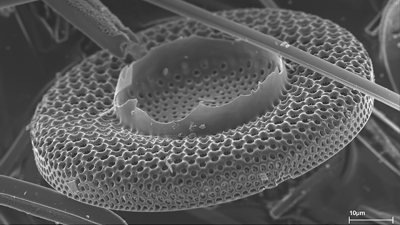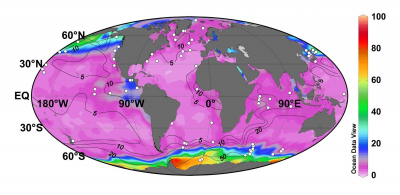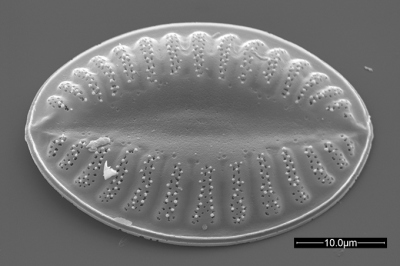Page path:
- Home
- Discover
- Media Releases
- Media Releases 2015
- Successfull diatoms
Successfull diatoms
Every day marine microalgae called diatoms take up 70 million tons of inorganic carbon from seawater to produce organic matter, a part of which sinks out into the deep ocean and sediments. This mechanism referred to as the oceanic biological pump reduces the concentration of carbon dioxide in the atmosphere as it diffuses into the upper ocean to compensate for the loss of sinking carbon. Over the last 40 million years continental erosion has increased the strength of the biological pump by stimulating the growth of marine diatoms.
Diatoms appear in the Mesozoic about 200 million years ago as descents of the red algal lineage. However, it is not until the second half of the Cenozoic era, ca. the last 40 million years that this group of marine microalgae turns into one of the most prominent primary producers on Earth. The causes of their take over might be on the continents rather than in the ocean itself according to our study published in the journal Proceedings of the National Academy of Sciences (PNAS).
Unlike other microalgae, diatoms require silicic acid to form tiny cases of amorphous silica (glass) called frustules, which they use as a means of defense against predators. Understanding what controls the amount of silicic acid in the ocean is essential to decipher the causes of the ecological success of diatoms, and here is where continental geology comes into play. Silicate rocks such as granites and basalts comprise the majority of Earth's crust and their erosion represents a major source of silicic acid to the world oceans. Continental erosion depends on a complex interaction of physical, chemical and biological forces that ultimately combine to enhance the dissolution of minerals that make up the rocks. The elevation of mountain ranges such as the Himalayas over the last 40 million years favored the fracture and dissolution of continental silicate rocks facilitating the expansion of diatoms in marine ecosystems.
Global quantification of elemental fluxes across Earth's surface compartments underlines the magnificence of geological and biological forces involved in the rearrangement of mineral constituents. Further understanding of these geobiological interactions will provide basic knowledge for the development of natural technologies aimed at mitigating the effects of anthropogenic carbon dioxide emissions. Enhancement of continental weathering and the resulting ocean fertilization potentially might contribute to reduce atmospheric carbon dioxide levels by increasing the strength of the biological pump. This research topic deserves further exploration.
Diatoms appear in the Mesozoic about 200 million years ago as descents of the red algal lineage. However, it is not until the second half of the Cenozoic era, ca. the last 40 million years that this group of marine microalgae turns into one of the most prominent primary producers on Earth. The causes of their take over might be on the continents rather than in the ocean itself according to our study published in the journal Proceedings of the National Academy of Sciences (PNAS).
Unlike other microalgae, diatoms require silicic acid to form tiny cases of amorphous silica (glass) called frustules, which they use as a means of defense against predators. Understanding what controls the amount of silicic acid in the ocean is essential to decipher the causes of the ecological success of diatoms, and here is where continental geology comes into play. Silicate rocks such as granites and basalts comprise the majority of Earth's crust and their erosion represents a major source of silicic acid to the world oceans. Continental erosion depends on a complex interaction of physical, chemical and biological forces that ultimately combine to enhance the dissolution of minerals that make up the rocks. The elevation of mountain ranges such as the Himalayas over the last 40 million years favored the fracture and dissolution of continental silicate rocks facilitating the expansion of diatoms in marine ecosystems.
Global quantification of elemental fluxes across Earth's surface compartments underlines the magnificence of geological and biological forces involved in the rearrangement of mineral constituents. Further understanding of these geobiological interactions will provide basic knowledge for the development of natural technologies aimed at mitigating the effects of anthropogenic carbon dioxide emissions. Enhancement of continental weathering and the resulting ocean fertilization potentially might contribute to reduce atmospheric carbon dioxide levels by increasing the strength of the biological pump. This research topic deserves further exploration.
Publication:
Continental erosion and the Cenozoic rise of marine diatoms
Pedro Cermeño, Paul G. Falkowski, Oscar E. Romero, Morgan F. Schaller, and Sergio M. Vallina
PNAS, doi: 10.1073/pnas.1412883112
Continental erosion and the Cenozoic rise of marine diatoms
Pedro Cermeño, Paul G. Falkowski, Oscar E. Romero, Morgan F. Schaller, and Sergio M. Vallina
PNAS, doi: 10.1073/pnas.1412883112
More information / interview / images:
Jana Stone
MARUM Public Relations
Phone +49-421-218 65541
Email: [Bitte aktivieren Sie Javascript]
Jana Stone
MARUM Public Relations
Phone +49-421-218 65541
Email: [Bitte aktivieren Sie Javascript]
Global map showing the surface concentration of silicic acid in the modern oceans (in micromol/kg at a water depth of 50 meters). Diatoms dominate along continental margins, the Equatorial Pacific, and the Southern Ocean. The white dots mark the sampling sites used to delineate the evolutionary trajectory of diatoms.
The marine diatom Cocconeis pinnata under the scanning electron microscope
Photo: O. Romero, MARUM





